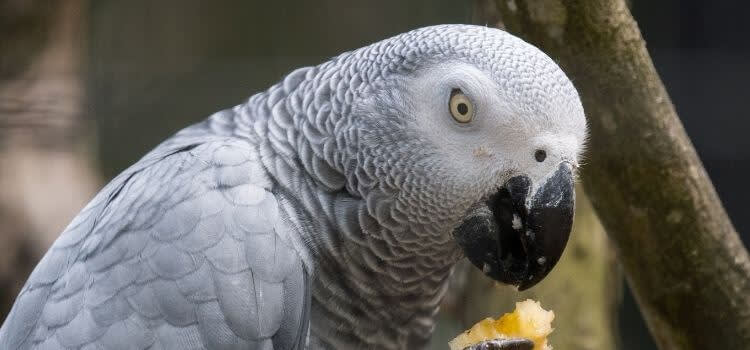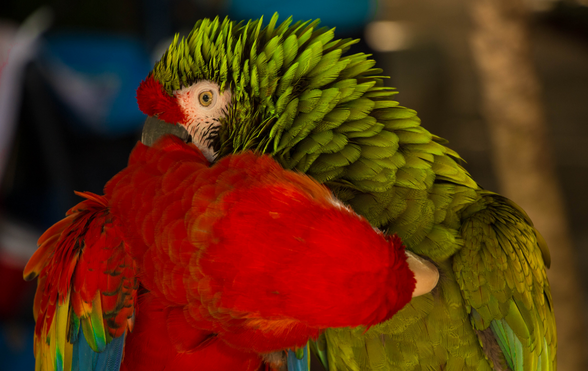UV exposure, calcium and magnesium can support your parrot’s body in a range of ways.
Is your parrot insured? Get a quote for up to £5,000 of vet fee cover, death and theft cover | We’ve been insuring exotic pets since 1996 | Check out our customer reviews on Feefo.
The importance of minerals for birds | Magnesium and your bird | Water for bird life | Natural vs supplementary D3 | How much UVI does my bird need? | Birds and feather plucking | UV and feather health | Specialist bird lamps
John Courteney-Smith MRSB FLS is Head of Science and Innovation at Arcadia Reptile and David Alderton is an expert in reptile and pet care.
Without the sun’s energy pouring down into our world, life could not exist. It creates a cascade effect, triggering and maintaining vital core processes within the skins layers, leading to the creation of vitamin D3.
 A healthy grey parrot housed in an outdoor aviary, exposed to direct sunlight.
A healthy grey parrot housed in an outdoor aviary, exposed to direct sunlight.
In turn vitamin D3 has widespread benefits through the body. It regulates the absorption, utilisation and storage of calcium.
Yet without the provision of calcium and other minerals through diet, then biological imbalances and ultimately disease will follow.
In the absence of sufficient calcium, the bones will become weak, the blood chemistry disturbed, and the nervous system will be affected.
A calcium deficiency can be primary, meaning that there is simply not enough in the bird’s diet. Seed is a particularly poor source of calcium. You can learn more about bird diet here.
Provision of avian supplements containing calcium and other minerals can help. Traditionally cuttlebone was used but is now less popular.
Calcium deficiency can also be caused through lack of vitamin D3. This is known as secondary calcium deficiency.
Although there may be sufficient calcium present in the diet, it cannot be absorbed and utilised by the body.
 Green-winged macaws eating clay on a cliff face in South America. This activity provides them with vital minerals.
Green-winged macaws eating clay on a cliff face in South America. This activity provides them with vital minerals.
The importance of minerals for birds
In the wild, minerals in the earth are available to birds via the foods they consume and the water they drink. Particles can also attach to their food, offering mineral enrichment.
Parrots also eat clays to bind plant toxins that are present in their food. Clay is laden with minerals, giving a vital significance to its consumption.
Calcium is important for life, and the body will do all it can to maintain the correct levels in the blood. If calcium levels fall the organs cannot function properly, and muscle contraction is adversely affected.
The body will draw calcium from the bones, to protect muscle contraction in the heart and other organs.
Magnesium and its role in your bird’s body
There are inter-relationships between minerals as well, notably calcium and magnesium.
Magnesium is usually obtained by birds through eating the soil, vertebrates and plants.
This chemical is vital in its own right, serving to ensure brain, nerve, digestive and reproductive health, but it is also essential to the calcium cycles.
Magnesium works as a sentinel, instructing calcium, and other minerals to be stored deep in the bones first, rather than getting lost in the soft tissues of the body where they are of no real use.
From the bones, calcium becomes viable and can be broken down as required, thanks to hormonal messengers carried in the bloodstream.
However, it has been suggested that since the second half of the 20th century, the increased use of commercial fertilisers may inhibit a plant’s ability to store this mineral, increasing the risk of a magnesium deficiency.
Supplementing with calcium/magnesium powders, as well as other minerals, has now become standard practice as a result, especially for seed-eating birds.
The role of water for bird life
This is vitally important for bird life. Water should have an adequate mineral content, not be distilled, and must be free from toxins and any serious bacterial contamination.
Water allows the cycles and processes of the body to occur, it flushes toxins away and can top up full-spectrum minerals.
We can provide perfect lighting and a perfect diet, but without good hydration, every cycle will be inhibited in some way.
Having constant access to water is vital within the D3 cycle for the assimilation, storage and use of minerals such as calcium.
Natural versus supplementary vitamin D3 for birds
It is exposure to UV-B predominately that starts the process of vitamin D3 production. But it is the balance of both UV-A and UV-B, that ensures this process is self-regulated and self-limiting.
Unlike oral supplements, D3 provided by balanced UV lighting systems cannot be easily oversupplied. The body will make enough D3 to satisfy its level of need. It then stores D3 for short term future use.
For a bird to be able to produce the correct volume of D3, it must be exposed to the correct quantity.
You can use the UV-Index (UVI) to measure this.
How much UVI does my bird need?
Looking at wild habitats, local weather and species behaviour an educated choice can be made on energy provision.
Typically, we provide a UVI of between 1.00 and 3.00 for most pet birds. This is a low and safe level replicating early to mid-morning sunlight.
The lower level of UV will allow a formation of D3 over time.
For birds in well planted out aviaries, a slightly higher UVI could be supplied. The plants and foliage will replicate the cover these offer in the wild.
With additional access to the right vitamins and minerals, birds will not only feel healthier, but will be able to process calcium just as they would in the wild.
This will help to ensure good bone density, excellent feather, beak and nail production along with viable eggs that can be laid easily.
 Grey parrots are prone to feather-plucking, and are also known to be vulnerable to calcium deficiency – known as hypocalcaemia. These issues may be linked.
Grey parrots are prone to feather-plucking, and are also known to be vulnerable to calcium deficiency – known as hypocalcaemia. These issues may be linked.
Birds and feather plucking
Feather plucking in birds is a very complex issue and there are many schools of thought as to why some birds display this behaviour and how to solve it.
Feather plucking certainly in the early stages, is usually always a means adopted by birds to expose skin, in order to receive more sunlight, increase the uptake of available dietary calcium and re-balance their blood chemistry.
The bird will remove an increasing amount of feathers and its health will gradually deteriorate.We know that a serious lack of D3 and calcium has a negative impact on the brain and behaviour meaning that feather plucking may become habitual even if the blood chemistry profiles are restored to normal levels.
It is relatively rare for a bird to pluck its own feathers when housed in an outdoor aviary with direct access to sunlight. Although there can be other causes of feather-plucking, this is a serious and common situation that has only been appreciated relatively recently.
The good news is that most birds, based on my experiences, have totally recovered and stopped plucking if the situation is dealt with early, with other causes excluded.
I have seen some serious cases over the years, but I have also observed some miraculous recoveries.
These have involved birds being given access to UV and a balanced provision of full-spectrum minerals. This has been supported by specialist avian vet access and regular blood testing. You can find a vet here.
UV and feather health
Being exposed to natural daylight or a replica source, such as a full-spectrum+UVB bird lamp, also has a positive direct impact on feather health.
UV can also increase the quality of oils produced by the preen gland. The preen gland is important to birds as it provides a source of ingestible vitamin D3 within the preen oil.
Feather and skin-dwelling bacterial loads can decrease, as may parasite numbers.
As has been mentioned in the Benefits of UV lighting for birds, the preen gland is positively impacted by natural UV, and provides a source of ingestible vitamin D3 within the preening oil.
Specialist bird lamps
As discussed in the Benefits of UV lighting for birds, specialist bird lamps should be referred to as being ‘full-spectrum+UV-B’.
Any lamp can be loosely thought of as being full-spectrum just by producing a colour of light that is similar to natural daylight.
These general purpose lamps, especially those that are LED, have little to no positive impact on the health and well-being of a bird other than enabling a circadian rhythm (based on light and darkness) to be established.
You should be aware of lamps marked solely as ‘daylight, full-spectrum, SAD’ and of course ‘LED’.
If a ‘warning triangle’ is not displayed on the UV lamp box, it can be assumed the lamp is of very little UV value.
If we are to see the greatest possible benefits for indoor birds, we must use specialist lamps. These are designed to mimic the energy output of the sun, producing UV-A and UV-B.
This article has been reproduced for Exotic Direct with the kind permission of John Courteney-Smith MRSB FLS, in conjunction with David Alderton. Many thanks for their support.
The content is owned by John Courteney-Smith MRSB FLS and cannot be reproduced without his permission.
Is your parrot insured? Get a quote for up to £5,000 of vet fee cover, death and theft cover | We’ve been insuring exotic pets since 1996 | Check out our customer reviews on Feefo.

